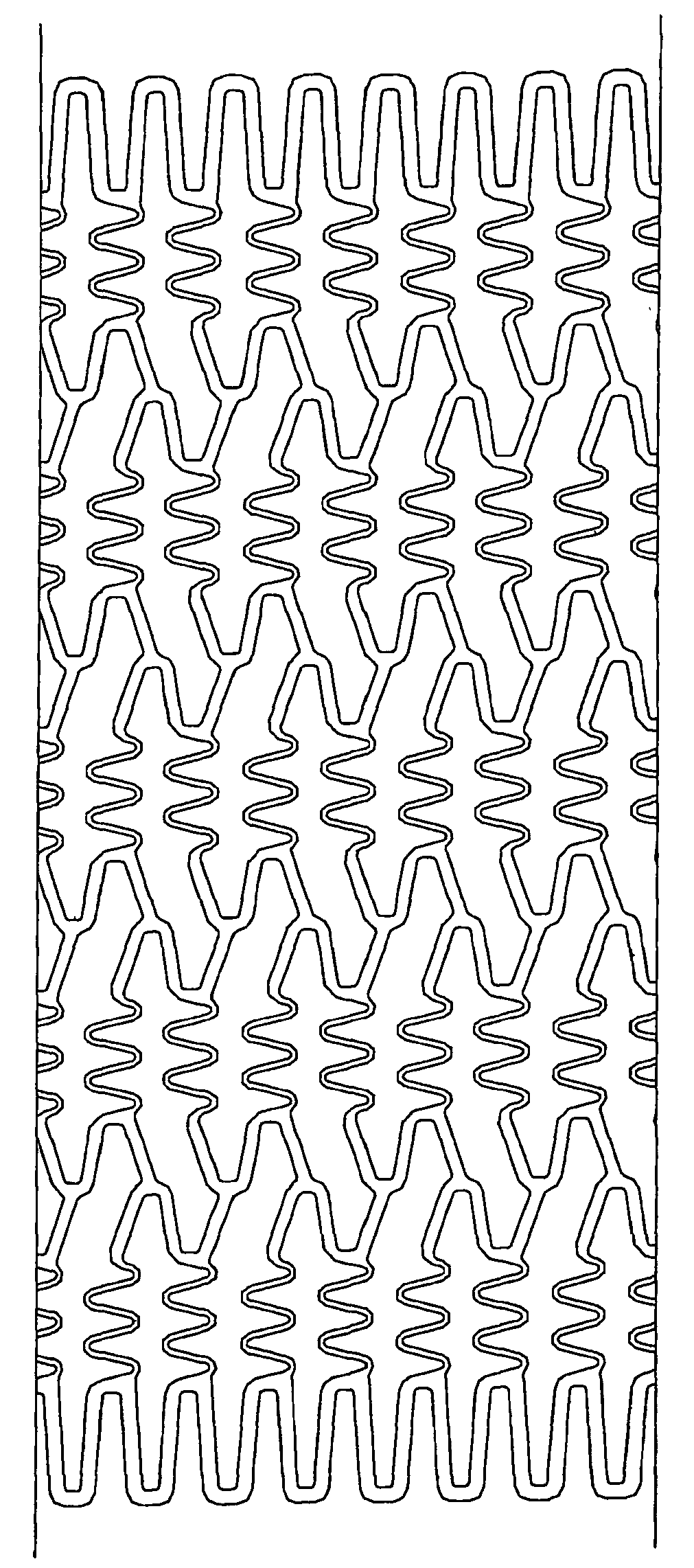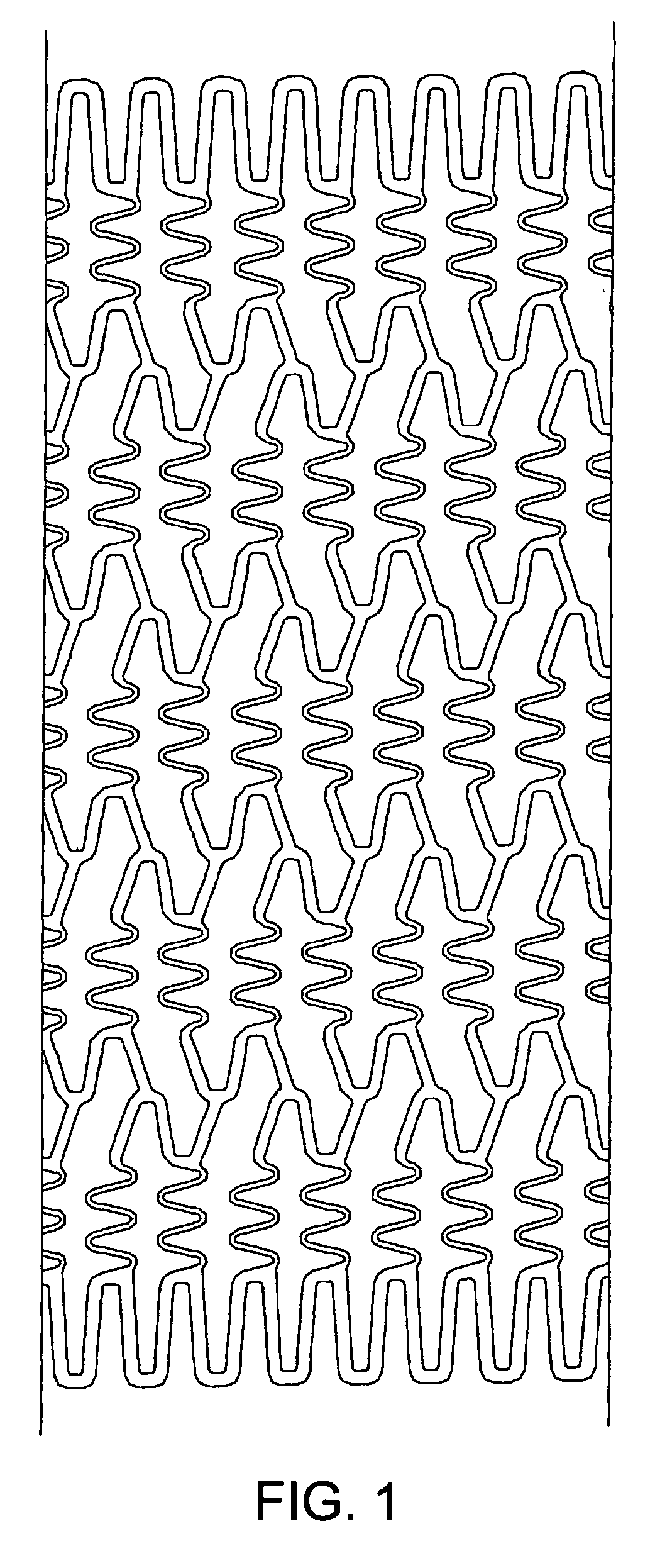[0038] Preferred examples of the material nondegradable in vivo used in the present invention include
metal materials, such as stainless steel, a Ni—Ti
alloy, a Cu—Al—
Mn alloy,
tantalum, a Co—Cr
alloy,
indium,
indium oxide, and
niobium. (The material nondegradable in vivo used in the present invention is not strictly required to be nondegradable in vivo, and it is sufficient that the shape can be maintained over a relatively long period of time. Hereinafter, the term “substrate” may be used as a term indicating a portion made of a material nondegradable in vivo in the present invention.) The substrate of the stent can be formed by the same method as that commonly used by a person skilled in the art in which a cylindrical
metal tube is
cut into a
stent design by
laser cutting and then electrolytically polished. However, the forming method is not limited to this, and an
etching method, a method including
cutting a plate
metal with a
laser,
rounding the plate, and then
welding, a method of knitting a metal wire, or the like can be also used. In the present invention, the material nondegradable in vivo is not limited to metal materials, and other
usable examples include polymer materials, such as polyolefins,
polyolefin elastomers, polyamides,
polyamide elastomers, polyurethanes,
polyurethane elastomers, polyesters,
polyester elastomers, polyimides,
polyamide-imides, and polyether
ether ketones; and
inorganic materials, such as ceramics and hydroxyapatite. A method for forming the stent substrate using such a polymer material or inorganic material does not
restrict the
advantage of the present invention, and any desired
processing method suitable for each material can be arbitrarily selected. Since the stent of the present invention contains the nondegradable material, the strength shortage of the stent can be prevented, and variations in strength of the stent in
actual use can be decreased. The nondegradable material is more preferably disposed so as to form the skeleton of the stent.
[0039] In the representative embodiment of the present invention in which only the poly (lactide-co-glycolide) is contained, the weight-average molecular weight of the poly (lactide-co-glycolide) is preferably 5,000 to 130,000. The
molar ratios of
lactic acid and
glycolic acid which constitute the poly (lactide-co-glycolide) are preferably 50 mol % to 85 mol % and 15 mol % to 50 mol %, respectively. By controlling the weight-average molecular weight and the
molar ratios of
lactic acid and
glycolic acid in the respective ranges described above, the
biodegradation rate of the poly (lactide-co-glycolide) can be controlled, thereby realizing a low rate of restenosis.
[0040] In use of the poly (lactide-co-glycolide) having a weight-average molecular weight of 5,000 to 130,000 and the
lactic acid and
glycolic acid molar ratios of 50 mol % to 85 mol % and 15 mol % to 50 mol %, respectively, restenosis within and around the stent can be suppressed by a balance between tissue stimulation, degradation rate, and the like. This is remarkable in comparison to a stent not containing a poly (lactide-co-glycolide). Also, by controlling the weight-average molecular weight and the molar ratios of lactic acid and glycolic acid in the respective ranges described above, the
biodegradation rate of the poly (lactide-co-glycolide) can be controlled, thereby realizing a low rate of restenosis.
[0041] The weight of the poly (lactide-co-glycolide) contained in the stent is preferably 3 μg / mm to 80 μg / mm per unit length in the axial direction of the stent, and more preferably 7 μg / mm to 65 μg / mm per unit length in the axial direction of the stent. When the weight of the poly (lactide-co-glycolide) contained in the stent is excessively small, the effect thereof is low, and the rate of restenosis is substantially the same as in a case not using the poly (lactide-co-glycolide) Conversely, when the weight is excessively large, like in a stent entirely composed of only the poly (lactide-co-glycolide), inflammatory reaction accompanying degradation of the poly (lactide-co-glycolide) becomes excessive, thereby relatively increasing the rate of restenosis. When the weight of the poly (lactide-co-glycolide) contained in the stent is 3 μg / mm to 80 μg / mm per unit length in the axial direction of the stent, as described above, the rate of restenosis is decreased, as compared with a stent not containing the poly (lactide-co-glycolide). When the weight of the poly (lactide-co-glycolide) contained in the stent is 7 μg / mm to 65 μg / mm per unit length in the axial direction of the stent, the effect becomes more significant.
[0042] In the other representative embodiment of the present invention which includes the poly (lactide-co-glycolide) and the immunosuppressive agent, the weight-average molecular weight of the poly (lactide-co-glycolide) is preferably 5,000 to 130,000. The molar ratios of lactic acid and glycolic acid which constitute the poly (lactide-co-glycolide) are preferably 50 mol % to 85 mol % and 15 mol % to 50 mol %, respectively. By controlling the weight-average molecular weight and the molar ratios of lactic acid and glycolic acid in the respective ranges described above, the
biodegradation rate of the poly (lactide-co-glycolide) can be controlled, and the immunosuppressive agent contained in the stent can be efficiently transferred to a target portion to be treated. As a result, a very low rate of restenosis can be realized.
[0043] In use of the substrate including the poly (lactide-co-glycolide) having a weight-average molecular weight of 5,000 to 130,000 and the lactic acid and glycolic acid molar ratios of 50 mol % to 85 mol % and 15 mol % to 50 mol %, respectively, restenosis within and around the stent can be suppressed by a balance between tissue stimulation, degradation rate, and the like. This is remarkable in comparison to a stent not containing a poly (lactide-co-glycolide). Also, by controlling the weight-average molecular weight and the molar ratios of lactic acid and glycolic acid in the respective ranges described above, the biodegradation rate of the poly (lactide-co-glycolide) can be controlled, and the immunosuppressive agent contained in the stent can be efficiently transferred to a target portion to be treated, thereby realizing a very low rate of restenosis.
 Login to View More
Login to View More  Login to View More
Login to View More 


